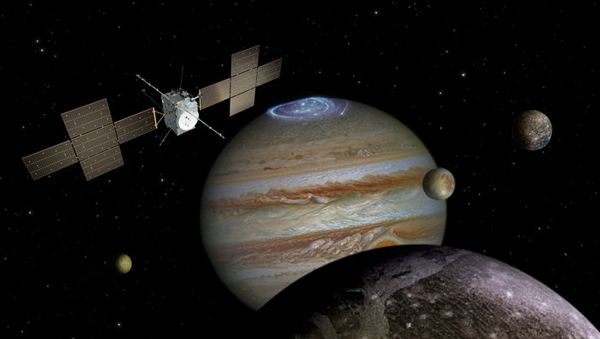
Spacecraft: ESA / ATG medialab; Jupiter: NASA / ESA / J. Nichols (University of Leicester); Ganymede: NASA / JPL; Io: NASA / JPL / University of Arizona; Callisto and Europa: NASA / JPL / DLR
Exploring Jupiter (Press Release)
It may still be five years away from launch, and over a decade before our Jupiter Icy Moons Explorer reaches the gas giant and its icy moons, but preparations are well under way. This new artist’s impression depicts the final spacecraft design, the construction of which is being overseen by Airbus Defence and Space.
The spacecraft’s solar wings form a distinctive cross-shape totalling 97 sq m, the largest ever flown on an interplanetary mission. The size is essential to generate sufficient power – around 850 W – for the instruments and spacecraft so far from the Sun.
The spacecraft is furnished with a laboratory of instruments that will investigate Jupiter’s turbulent atmosphere and vast magnetosphere, as well as study the planet-sized moons Ganymede, Europa and Callisto. All three moons are thought to have oceans of liquid water beneath their icy crusts and should provide key clues on the potential for such moons to harbour habitable environments.
Juice’s cameras will capture exquisite details of the moons’ features, as well as identify the ices and minerals on their surfaces. Other instruments will sound the subsurface and interior of the moons to better understand the location and nature of their buried oceans. The tenuous atmosphere around the moons will also be explored.
The spacecraft will also include booms such as a 10 m-long magnetometer mast (seen towards the bottom of Juice in the artist impression), a 16 m radar antenna (the long boom across the top), and antennas to measure electric and magnetic fields.
Ganymede is the only moon in the Solar System to generate its own internal magnetic field, and Juice is well equipped to document its behaviour and explore its interaction with Jupiter’s own magnetosphere.
Juice is scheduled for launch in 2022 on a seven-year journey to the Jovian system. Its tour will include a dedicated orbit phase of Jupiter, targeted flybys of Europa, Ganymede and Callisto, and finally nine months orbiting Ganymede – the first time any moon beyond our own has been orbited by a spacecraft.
In the artist’s impression, which is not to scale, Ganymede is shown in the foreground, Callisto to the far right, and Europa centre-right. Volcanically active moon Io is also shown, at left. The moons were imaged by NASA’s Galileo spacecraft; Jupiter is seen here with a vivid aurora, captured by the NASA/ESA Hubble Space Telescope.
Source: European Space Agency

No comments:
Post a Comment